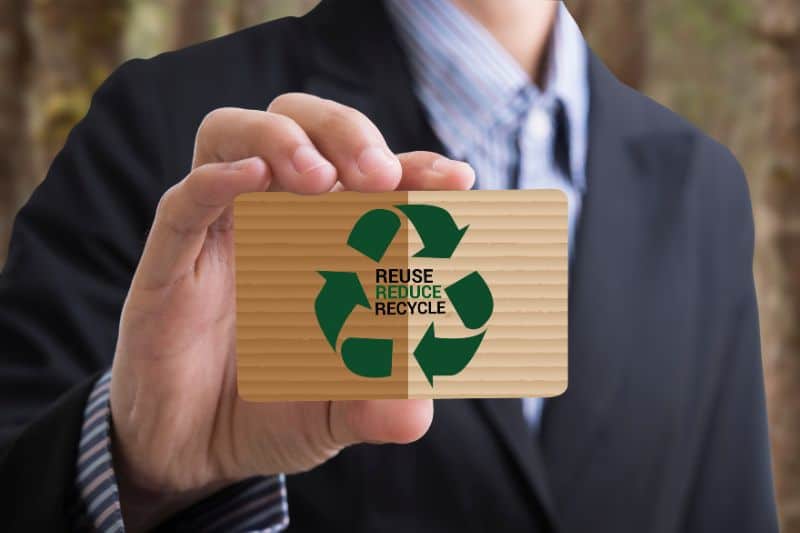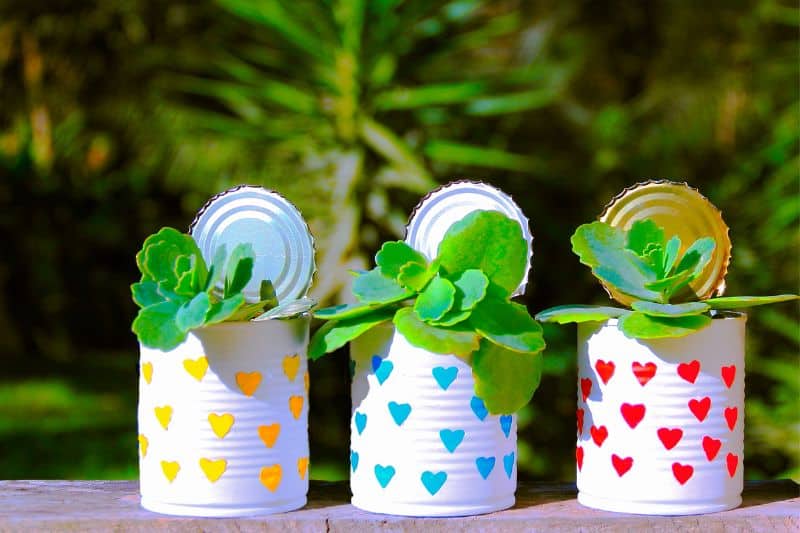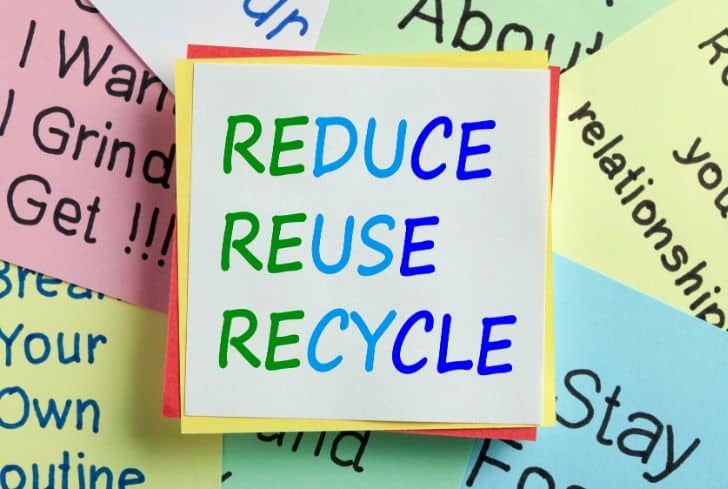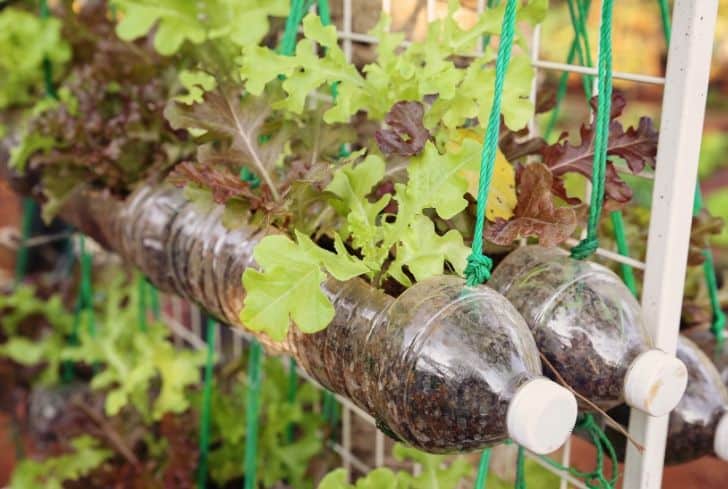If you have heard of something called the “waste hierarchy,” you may wonder what that means. It is the order of priority of actions to reduce the amount of waste generated and improve overall waste management processes and programs.
The waste hierarchy consists of 3 R’s as follows:
- Reduce
- Reuse
- Recycle
They are commonly called the “three R’s” of waste management, this waste hierarchy is the guidance suggested for creating a sustainable life. You might be wondering how to incorporate these principles into your daily life.
Relax!
They are not that hard to implement. All you need is to bring a small change in your daily lifestyle to reduce waste so that less amount of it goes to the landfill, which can reduce your carbon footprint.

It makes a big difference to recycle. It makes a big difference to reuse things, not to use the paper cup – and each time you do, that’s a victory.
~ Emily Deschanel
As per the Missouri Department of Natural Resources,
“The three R’s – reduce, reuse and recycle – help to cut down on the amount of waste we throw away. They conserve natural resources, landfill space and energy. They save land and money that communities must use to dispose of waste in landfills. Siting a new landfill has become difficult and more expensive due to environmental regulations and public opposition.“
By refusing to buy items you don’t need, reusing them more than once, and disposing of those that are no longer in use at appropriate recycling centers, you contribute towards a healthier planet.
The First ‘R’ – Reduce
The concept of reducing what is produced and what is consumed is essential to the waste hierarchy. The logic behind it is simple to understand – if there is less waste, there is less to recycle or reuse.
The’ reduce’ process begins with examining what you use and what it is used for. There are three simple steps to assessing the reduction value of an item or process, as elaborated below.
Step 1: Can something else be used for this purpose?
Using multi-use items is essential to beginning reduction. One example would be a coffeepot and a cappuccino maker. Both distinctly do different things, but you can buy a coffeepot with a steaming attachment on it to do both.
Purchasing one of the two items means you don’t need to use the two separately. It reduces the amount of production and waste packaging material needed.
Step 2: Is this something that needs to be done?
A lot of our waste material comes from items that are considered to be “disposable”.
Not in the sense that you use something once and then throw it away, that can actually be a part of environmental responsibility when working with medical items.
Disposable, in this sense, questions the usefulness of the item. In other words, is what you intend to do with the item important?
Step 3: Is the item a part of something you need or want to do in your life?
There is a limit to what you need to be prepared for. Chances are you won’t need a car equipped to handle a sandstorm in the desert.
Buying one encourages production, wastes your resources, and creates more generative waste than you can imagine. Always ensure that what you consume or keep in your life as preparation matches the reality of potential opportunity in your life.
Here are some of the things you can do to reduce waste:
- Print on both sides of the paper to reduce their wastage.
- Use electronic mail to reach out to people instead of sending paper mail.
- Remove your name from the mailing lists that you no longer want to receive.
- Use cloth napkins instead of paper napkins.
- Avoid using disposable plates, spoons, glasses, cups, and napkins. They add to the problem and result in a large amount of waste.
- Avoid buying items that are over-packaged with foil, paper, and plastic. This excess packaging goes to waste.
- Buy durable goods that have an extended warranty. They generally run longer and save landfill space.
- Use refillable pens instead of buying too many.
- Purchase multi-tasking products that perform different kinds of jobs at a go.
- Something with no valid purpose or real use adds to your waste. If you’re not using any item for long, it’s time to put it away.
Number 3 deals with the problems created by living in a culture of consumerism. This consumption-driven culture also makes fulfilling the second “R” difficult, but it gets easier.
The Second ‘R’ – Reuse
You may have a box of broken stuff or things you no longer use but hang on to them in case you find another use for them, or you may find bargains on old furniture or go trash picking and get things you can refinish.
In either case, you are working towards reusing the item. Learning to repurpose them for a different use than intended is essential in the waste hierarchy.
One of the best examples of how this is being done today is the modular construction of homes and office buildings that are being created out of discarded shipping containers.
These large, semi-truck-sized metal containers represent a huge waste problem. Repurposing them as homes and offices saves them from landfills and doesn’t require additional expenditure of natural resources to melt down and reconfigure the metals used to create them.
You may reuse or donate those items so others can use them.
Reuse the below items:
- Old jars and pots: Old jars and pots can be used to store items in the kitchen and can also be used to store loose items together, such as computer wires.
- Tires: Old tires can be sent to the recycling station or used to make tire-swing.
- Used wood: Used wood can be used as firewood or can be used as woodcraft.
- Newspaper: Old newspapers can be used to pack items when planning to move to another home or store old items.
- Envelopes: Children can use old and waste envelopes to make short notes.
- Waste paper: They can be used to make notes and sketches and sent to the recycling center when you don’t need them anymore.
- Old jeans, T-shirts, or any clothes: These can be turned into bags or tote bags with the help of tutorials available on the internet. They can also become cleaning rags.

Donate the below items:
- Old books: Poor children can use old books or donate them to public libraries.
- Old clothes: Your unwanted clothes can be used by street children or donated to charity institutions.
- Old electric equipment: One can donate any old electric equipment to schools or NGOs.
- Rechargeable batteries: Rechargeable batteries can be used repeatedly and help reduce unnecessary wastage as opposed to regular batteries.
- Build your own compost bin: Use the compost bin to put waste items like used tea bags, tea leaves, grains, fruit peels, etc. The waste then degrades and becomes compost that helps plants grow and shine.
- Be creative: Apply DIY on old clothes, bottles, jars, pots, vases, or anything else to convert them into other utilities and use them further.
- Repair damaged items: Repairing items enables reuse again without buying replacements.
- Second-hand stores: Visit these stores and purchase second-hand goods. Second-hand stores and garage sales offer usable items in better condition and will save you money rather than buying new ones.
The Third ‘R’ – Recycling
The last stage of the waste hierarchy is recycling. Recycling something means it will be transformed again into a raw material that can be shaped into a new item. However, very few materials on the earth cannot be recycled.
One of the issues bothering communities that want to become more involved with a recycling effort is that while the relying collection and sorting process may be affordable to implement, there still has to be a facility to receive and transform the discarded waste into a raw material to produce new products.
More progress is being made toward uniting recycling plants with industries that can process the waste material through agreements and incentive credits.
One needs to learn the products that can be recycled and which cannot. By carefully choosing the products that can be recycled, it can be the first step towards efficient recycling.
- Buy products from the market made of recycled materials, i.e.; the product should be environment friendly.
- All products are recyclable such as some plastics. There is usually a recycling symbol on the bottom of products to know whether or not it is recyclable.
- Buy products that can be recycled, like paper, glass, aluminum, plastic, etc., used in the house, school, or office. Aluminum can be recycled multiple times.
- Invent new ways to recycle different items. However, recyclables need to be gathered systematically and separated from the rest of the trash, ensuring a continuous supply for the recycling process.
- Avoid buying hazardous materials that could pose difficulty for you to recycle. Buy non-toxic products whenever possible.
- Buy products that have been made from recycled materials.
- Using recycled products is as important as recycling items. Recycling can become economically viable only when the recycled products are given significance and put to use.
- Use recycled paper for printing or making paper handicrafts.
Benefits of the ‘Reduce, Reuse, Recycle’ Waste Hierarchy
- Since there will be a significant reduction in the amount of waste thrown into the environment, the chances of spreading toxins also decrease. It automatically reduces the levels of greenhouse gas emissions and pollution.
- The Waste Hierarchy eliminates the practice of improper waste disposal, i.e., burning waste and trash haphazardly in an uncontrolled manner. Rather it enables us to manage waste in an eco-friendly manner lessening the risk of environmental damage.
- The primary objective of the 3R principle is to lessen the use of newer resources and energy, making more efficient use of resources. It promotes resource efficiency by using the already available resources that are used multiple times, reprocessed, or entirely reduced.
- It contributes to more sustainable energy consumption as the resources available on hand are used, and excessive consumption is reduced. It promotes the sustainability of energy, resources, and the environment.
- It encourages the development of green technology to create cleaner, safer means of waste disposal while reducing the impact on the environment and all habitats.
- It increases the use of renewable energy sources like solar, wind, geothermal, etc.
- The 3Rs conserve energy and resources, generate resource management jobs, and boost the economy.
Shift from 3Rs to 4Rs
The Fourth ‘R’ – Recover
Another ‘R’ is added to the already known 3Rs waste hierarchy, making it 4Rs. That fourth ‘R’ is recovering. The 4Rs solutions often emerge due to industry benchmarking or technological breakthroughs in more innovative companies.
After applying the 3Rs, it may be possible to recover materials or energy from waste like electricity, heat, fuel, and compost through thermal and biological means, which cannot be reduced, reused, or recycled.
This can be done by:
- Sending treated wastes to a landfill where they will biodegrade away to rejuvenate the land again.
- Solid wastes are burned at high temperatures in the incineration method and converted into residue and gaseous products.
- Non-recyclable waste is converted into usable heat, electricity, or fuel through varying processes and becomes a renewable energy source. Waste to Energy (WtE) helps lessen the need for fossil fuels and reduces carbon emissions.
- Composting, which is a natural biodegradable process, turns organic wastes into nutrient-rich food for plants. It is a slow process, but one of the best ways to turn unsafe organic products into safe compost.







